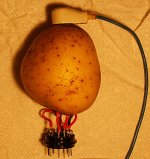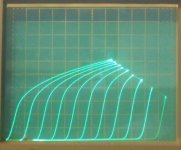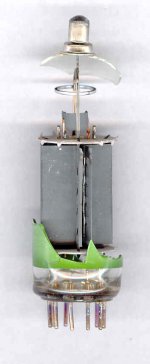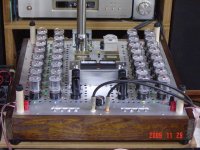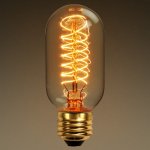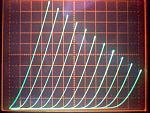That's fine, but some of his fans seem to think he is designing hi-fi.
If I put a toilet seat in the middle of a field and put a notice on it saying "Toilet seat 2016" then most people would realise that it was a piece of 'art'. I could even write a good story about the futility of evacuation as it only solves the problem for a few hours - or get an art journalist to write the story.
If I put a toilet seat in the middle of a field and put a notice on it saying "Public Convenience" would most people think it was a genuine public loo, but lacking the boring engineering features of walls, doors, plumbing, washbasins, towels etc.? I suspect not - they would know I was having a laugh. Some might even think it was 'art'. Few would think it was a usable toilet.
I don't object to 'art'; if people want to spend their money on ugly useless stuff then they are free to do so. Similarly if someone wants to make an electronic circuit with valves used as resistors, and transformers attached at one end only (or with shorted windings), and random pieces of wire (to catch the 'groundside electrons') then they can do so as long as everyone knows this is not hi-fi and not really sensible electronics intended to have an electronic function; it may have other functions such as publicity for the designer or remote extraction of the contents of wallets.
Rant mode off!
If I put a toilet seat in the middle of a field and put a notice on it saying "Toilet seat 2016" then most people would realise that it was a piece of 'art'. I could even write a good story about the futility of evacuation as it only solves the problem for a few hours - or get an art journalist to write the story.
If I put a toilet seat in the middle of a field and put a notice on it saying "Public Convenience" would most people think it was a genuine public loo, but lacking the boring engineering features of walls, doors, plumbing, washbasins, towels etc.? I suspect not - they would know I was having a laugh. Some might even think it was 'art'. Few would think it was a usable toilet.
I don't object to 'art'; if people want to spend their money on ugly useless stuff then they are free to do so. Similarly if someone wants to make an electronic circuit with valves used as resistors, and transformers attached at one end only (or with shorted windings), and random pieces of wire (to catch the 'groundside electrons') then they can do so as long as everyone knows this is not hi-fi and not really sensible electronics intended to have an electronic function; it may have other functions such as publicity for the designer or remote extraction of the contents of wallets.
Rant mode off!
That's fine, but some of his fans seem to think he is designing hi-fi.
Yes, the point of performance art is to allow the audience to individually decide what it means to them. For example, Banksy's art (which I admire greatly) is not just in the visual representation which is the result, but encompasses the process, the location, the story around it, that is, the performance of its creation and existence. Some people think he's making great paintings. Some people think he's just a vandal. There's no right or wrong, his art is there to allow people to think about its meaning.
Not that I would put a niche performer like Sakuma into the same category- it's not great art, but it captures the imagination and stirs something in a subset of a subset of nerds. So it IS art, unlike some of the rampant hucksterism in audio which is merely a means to an end of transferring wealth.
My only interest in Banksy's art is to be mildly amused at the fuss people make about some vaguely competent graffiti. Constable is my sort of art, but even then I would rather visit the Essex/Suffolk border than look at a painting of it.
I suspect the mistake that many people make is looking for the deep meaning in the art, as intended by the artist; any meaning is not in the art but imposed upon it by the viewer - the artist either had no meaning in mind or could not tell the difference between triviality and profundity. So when people ask what Sakuma means by adding (random) components, and assume that he must understand electronics so much better than them (and his critics), they are asking the wrong question; if they knew that the extra components really were random then they might not ask such questions.
I suspect the mistake that many people make is looking for the deep meaning in the art, as intended by the artist; any meaning is not in the art but imposed upon it by the viewer - the artist either had no meaning in mind or could not tell the difference between triviality and profundity. So when people ask what Sakuma means by adding (random) components, and assume that he must understand electronics so much better than them (and his critics), they are asking the wrong question; if they knew that the extra components really were random then they might not ask such questions.
I suspect the mistake that many people make is looking for the deep meaning in the art, as intended by the artist; any meaning is not in the art but imposed upon it by the viewer - the artist either had no meaning in mind or could not tell the difference between triviality and profundity.
Or perhaps there's a third or fourth possibility- you seem to understand that there's an interaction between the art and the observer, but don't go the next step, which is to appreciate that as part of the art. "So when people ask what Sakuma means by adding (random) components..." then Sakuma has accomplished what he set out to do. It's art, not engineering, the "it" not meaning a specific amplifier, but the whole performance, the persona, the cult, the story, the acting, the fact that he has aroused a particular train of thought in the observer. The amplifier is just a means to this end. Like I said, it's not great art, and the audience to whom it speaks is an exceedingly small one (neither you nor I would be in it!), but it IS a performance piece.
One can appreciate the Barbizon artists as well as the Dadaists. Not mutually exclusive, just very different forms of art.
The problem with that is that it does not allow my contempt for most modern art to be accepted as such; I refuse to permit my contempt to be misconceived as legitimising that which I do not consider to be art. I would rather have the artist regard me as ignorant.
When I laugh at a piece of red canvas or an unmade bed I am not reacting to art and so legitimising it; I am rejecting that which is not art.
When I laugh at a piece of red canvas or an unmade bed I am not reacting to art and so legitimising it; I am rejecting that which is not art.
Oh, I fully accept that you have contempt for modern art. Like older forms of art, it still follows Sturgeon's Law. But just as there are people who think no great music was composed after 1890 because they don't understand Duke Ellington or Frank Zappa or Arnold Schoenberg, there are people who just cannot understand any art which is not representational in a pre-20th century sense. That doesn't change the fact that nonrepresentational forms are art, and can be judged accordingly as good art, great art, or lousy art.
Personally, I think Sakuma's art is lousy, but it's still art. It's not representational and it encompasses many elements- if I were to draw a rough parallel, it would be to Mad Kobayashi, the chef, who has created a story and a persona which transcends the food he creates. Except that Kobayashi is far more talented.
Personally, I think Sakuma's art is lousy, but it's still art. It's not representational and it encompasses many elements- if I were to draw a rough parallel, it would be to Mad Kobayashi, the chef, who has created a story and a persona which transcends the food he creates. Except that Kobayashi is far more talented.
Tube Art:
Attachments
Last edited:
If you know anything about Sakuma you would quickly realize that he was in no sense designing high fidelity audio equipment, and never said he was, his intent was to design something that in his terms captured/recreated the emotion of the music; that was always his very personal quest and primary goal. He had some interesting ideas along the way, his later ideas are so far outside of accepted audio engineering practice not to mention theory that many of us don't/can't take it seriously. Bit of a let down frankly.
I quite like the concept. It is a bit eccentric the way the power tube is used in the supply filter, but please note that the current trough the "shunt" is 15 times larger than the current in the gain stage, so the psu sees a "soft" static load. The second choke is 10 times larger value so current in the signal loop will see a much larger impedance looking toward the power supply. It feels like crude current fed shunt. I bet it sounds clean and with super rich and saturated tone rendition. Will try it some day.
Any additional steady load on the power supply makes the power line ripple worse.
The 300B looks like it was installed there for a play-off against the 841 tube originally. Then got wired in as an AC load for some mysterious reason.
Now if the 300B grid were driven by a sample of the AC ripple, it could remove the supply output ripple as an active Aikido style noise reducer.
The 300B looks like it was installed there for a play-off against the 841 tube originally. Then got wired in as an AC load for some mysterious reason.
Now if the 300B grid were driven by a sample of the AC ripple, it could remove the supply output ripple as an active Aikido style noise reducer.
Last edited:
You are absolutely right , but that is the art part in the Sakuma amp.
It will increase the psu ripple that is a repetitive noise but it will prevent the modulation of it and all the by products that are really annoying.
It will increase the psu ripple that is a repetitive noise but it will prevent the modulation of it and all the by products that are really annoying.
You are absolutely right , but that is the art part in the Sakuma amp.
It will increase the psu ripple that is a repetitive noise but it will prevent the modulation of it and all the by products that are really annoying.
Ok, Sakuma-san is looking for a sound of his own, nothing close to the sound of an acoustic instrument, rather a sound reminiscent of an old AM radio, albeit a very good one. Reaching that ideal sound is the art part.
But all this still does not explains why to use a complete SE triode stage to load the power supply: soundwise a bleeder resistor could do - more or less - the same (yes, I agree it helps).
So that would be bandwidth 200Hz to 8kHz, with a bass peak at the speaker resonance and numerous cabinet resonances, 10% distortion on peaks, and slew rate limiting on the downward side of negative peaks. Lovely! Oh, I forgot: -40dB hum too. And maybe -40dB whistle at 9/10kHz.CiroMarzio said:rather a sound reminiscent of an old AM radio
RE: CiroMarzio
"But all this still does not explains why to use a complete SE triode stage to load the power supply: soundwise a bleeder resistor could do - more or less - the same ..."
The 300B was already there for a playoff against the 841. So it became a convenient 40 Watt resistor to use, without the smell of burning phenolic added to the ambiance.
Improvement: short out the input xfmr load, and AC couple some power supply ripple to the 300B grid.
"But all this still does not explains why to use a complete SE triode stage to load the power supply: soundwise a bleeder resistor could do - more or less - the same ..."
The 300B was already there for a playoff against the 841. So it became a convenient 40 Watt resistor to use, without the smell of burning phenolic added to the ambiance.
Improvement: short out the input xfmr load, and AC couple some power supply ripple to the 300B grid.
Last edited:
So that would be bandwidth 200Hz to 8kHz, with a bass peak at the speaker resonance and numerous cabinet resonances, 10% distortion on peaks, and slew rate limiting on the downward side of negative peaks. Lovely! Oh, I forgot: -40dB hum too. And maybe -40dB whistle at 9/10kHz.
Well, almost...
think of an enhanced AM radio with less hum and no whistle 😉
Back in the nineties I happened to have in my lab a replica ( monophonic, of course! ) made by an Italian guy. Very well made, very close to Sakuma design. He used all the custom Tamura specified in the original design, and many of the same components. Cabinet and layout were very close to the original.
Bandwidth was like 60 Hz - 14 KHz - 3 dB, sound was very mellow, very pleasantly rich and fat. Not at all a natural sound but... not bad!
I have never listened to Sakuma amps made personally by him but after that first time I listened to a few other well made replicas and they had a similar "flavour".
Sakuma shoots for a sound that is different from the natural sound I am looking for, but IMHO his work is always interesting
The 300B was already there for a playoff against the 841. So it became a convenient 40 Watt resistor to use, without the smell of burning phenolic added to the ambiance.
Improvement: short out the input xfmr load, and AC couple some power supply ripple to the 300B grid.
Of course 300B looks and smells better than a couple of high power resistors
Why bother with any fancy parts, nonsensical bleeder, etc. when you can just use a tone control? Sakuma is the Rube Goldberg of audio design.😀Well, almost...
think of an enhanced AM radio with less hum and no whistle 😉
- Home
- Amplifiers
- Tubes / Valves
- Sakuma's bleeder tubes and series connected transfomers
